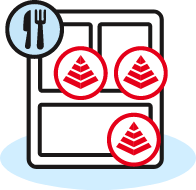 HPB Corporate Logo
Toggle mobile search bar
HPB Corporate Logo
Toggle mobile search bar
Healthier Dining Programme
Be Part of the Healthier Dining Programme
You are eligible to join the programme if:
- Your F&B business is registered and operating in Singapore
- You own more than one F&B business as part of a group that is registered and operating in Singapore, such as restaurants, food courts, caterers, etc.
How to join the HDP?
HDP application process:
APPLICATION
1
1
Application Details
Estimated processing time: 3 working days
Submit your application that details your company’s profile, list of outlets and use of healthier
ingredients.
You will require a CorpPass to login and access the HDP e-Services portal. All users have to be assigned the appropriate roles by your CorpPass Administrator for the application. (Please refer to Onboarding User Guide for steps on role assignment).
For a step-by step guide to help you complete the on-line application, please refer to the following resources or email HPB_Healthy_Eating@hpb.gov.sg:
You will require a CorpPass to login and access the HDP e-Services portal. All users have to be assigned the appropriate roles by your CorpPass Administrator for the application. (Please refer to Onboarding User Guide for steps on role assignment).
For a step-by step guide to help you complete the on-line application, please refer to the following resources or email HPB_Healthy_Eating@hpb.gov.sg:
- HDP application and submission user guide
- Application and submission guide for Event Caterers, Free-Flow Institutional Caterers and Buffet settings
- Application and submission guide for all other F&B companies (e.g. Restaurants, Quick Service, Cafés, Kiosks, Chains, Bakeries, Desserts, Institutional Caterers (stalls), Digital F&B Operators)
2
2
Nutrition Analysis
Estimated processing time: 2 weeks
HPB's Nutrition Service Provider will review your menu and identify potential menu items which can be
endorsed. The Nutrition Service Provider will conduct nutrition analysis and may suggest reformulation to help you
meet the nutrition guidelines.
APPROVAL
3
3
Approved Menu Items
Estimated processing time: 1 week
Suitable menu items are submitted by Nutrition Service Provider for HPB’s review and approval.
4
4
Licence Agreement
Estimated processing time: 3 working days
Indicate your agreement to the conditions within the Licence Agreement. Submit your menu artwork within 6 months.
5
5
Healthier Menus/Artwork
Estimated processing time: 1 week
Submit menu artwork draft for HPB review and approval. Upon artwork approval, print and utilise artwork for publicity
purposes.
As a HDP Partner, you would be expected to:

Offer 3 or more healthier food/beverage options

Follow and adhere to Nutrition and Publicity guidelines

Provide timely reports on the monthly sales information of your endorsed menu items
Nutrition and Publicity Guidelines
Nutrition Guidelines
- The HDP Nutrition Guidelines provide a description of nutrition requirements to qualify as a “healthier” food or beverage type
- The Healthier Dining Programme Sodium Guidelines provide a description of nutrition requirements to qualify as a “Lower in sodium” meal type.
- The Healthier Children’s Meal Guidelines provide a description of nutrition requirements to qualify as a “healthier” meal type to be served for children
Publicity Guidelines by Settings
To find out which F&B setting your company is applicable for and to view the Publicity Guidelines, please refer to the
table below.
DEFINITIONS OF F&B SETTINGS & PUBLICITY GUIDELINES
|
Restaurants
|
|
Quick Service Restaurants (QSRs)
|
|
Bakeries
|
|
Cafés
|
|
Drink Kiosks
|
|
Food Kiosks
|
|
Food Courts
|
|
Caterers (Events)
|
|
Caterers (Individuals)
|
|
Institutional Caterers (Free Flow)
|
|
Institutional Caterers (Stalls)
|
|
F&B Companies Operating Solely on Digital Platform(s)
|
|
Dessert
|
|
Buffets (Restaurants/Hotels)
|
|
Coffee Shops
|
|
Hawkers
|
|
Brand/Food Chain
|

